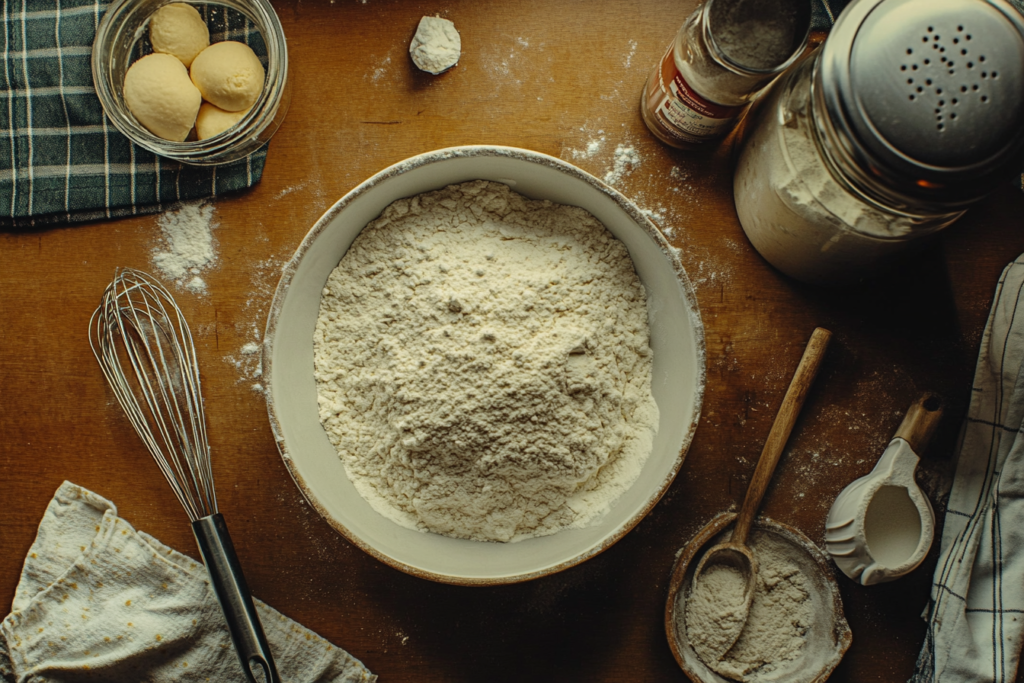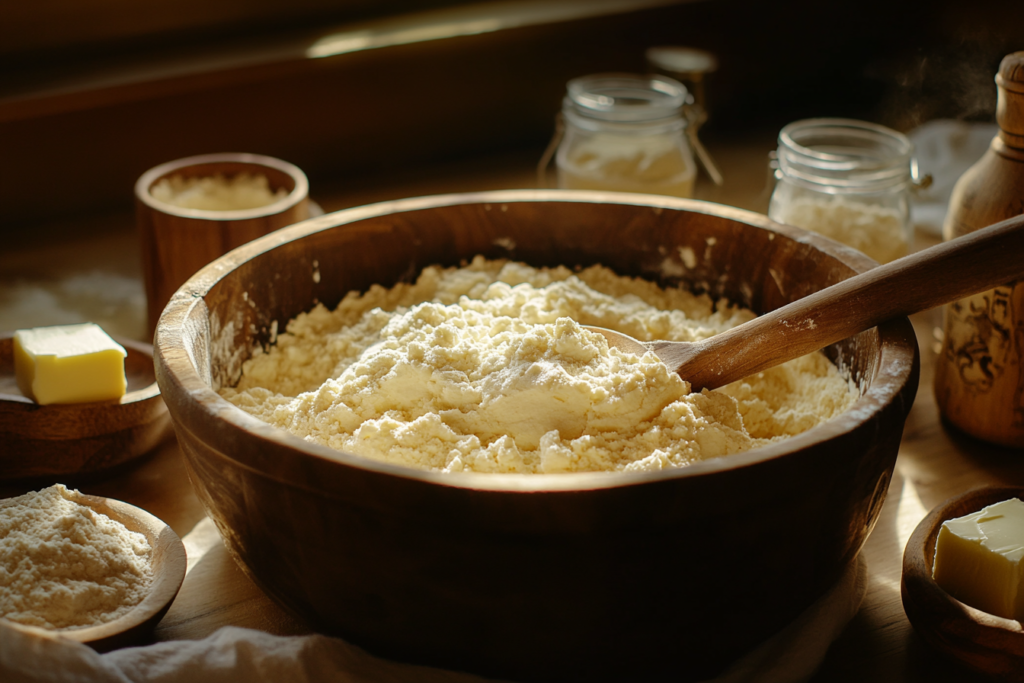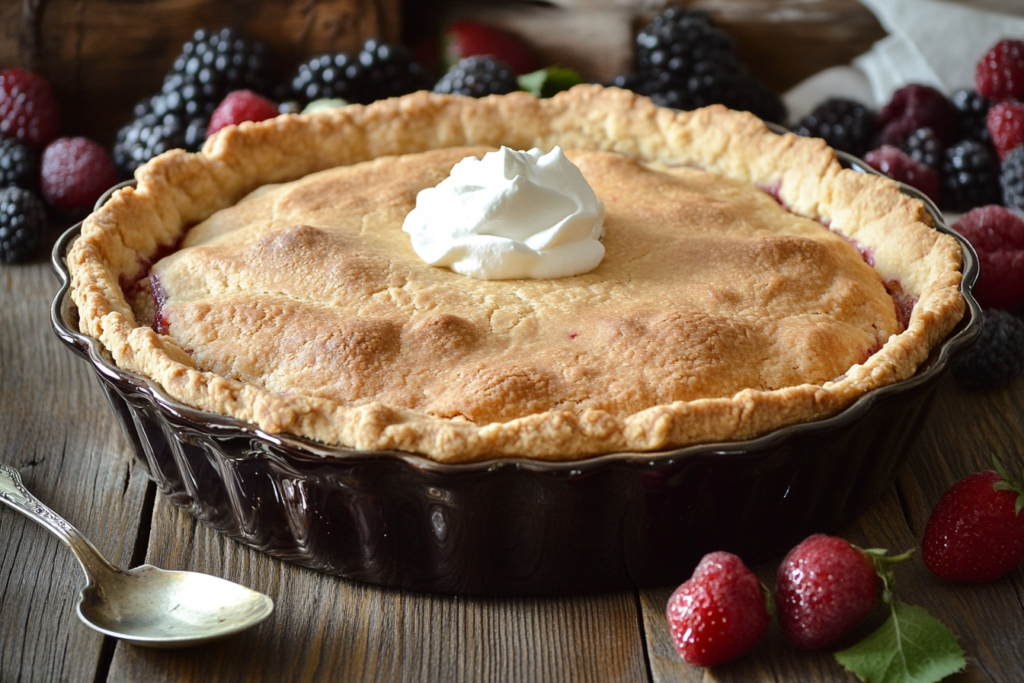Table of contents
- Understanding Bisquick: What It Is and How It’s Used
- Is Bisquick Just Flour and Baking Soda? A Closer Look
- How Bisquick Differs from Homemade Mixtures
- Can You Substitute Bisquick with Flour and Baking Soda?
- Common Problems When Using Bisquick and Their Solutions
- Healthier Alternatives to Bisquick
- Bisquick’s Role in Modern Kitchens
- The Future of Baking Mixes: Is Bisquick Here to Stay?
- Conclusion: The Versatility of Bisquick in Your Pantry
- FAQs
Understanding Bisquick: What It Is and How It’s Used
H3: The Origins of Bisquick
Ah, the story of Bisquick. It’s one of those classic tales of invention meeting convenience. Back in the 1930s, a General Mills salesman noticed a chef preparing a pre-mixed blend for biscuits. Inspired, he pitched the idea of a ready-made baking mix, and Bisquick was born. Think of it as the OG shortcut for busy bakers who wanted freshly baked goods without the fuss.
This ingenious mix was marketed as a way to whip up biscuits in record time. Over the years, its versatility expanded, and now, Bisquick is used in everything from waffles to casseroles.
“Bisquick wasn’t just a product; it was a revolution in the kitchen, turning home cooks into speedy bakers.”
Common Uses for Bisquick in Cooking and Baking
If you’ve got Bisquick in your pantry, the possibilities are endless. Pancakes and waffles? Easy. Biscuits? A breeze. Need a base for your quiche or chicken pot pie? Bisquick’s got you covered. It’s like the Swiss Army knife of baking mixes.
But wait, there’s more! People have used it for making pizza dough, dumplings, and even fried chicken batter. It’s no wonder Bisquick has remained a household name for nearly a century.
Is Bisquick Just Flour and Baking Soda? A Closer Look
Let’s get to the heart of the matter: Is Bisquick simply a mix of flour and baking soda? Well, not quite. While those two ingredients are definitely part of the mix, there’s a bit more going on in that box.

What Ingredients Make Up Bisquick Besides Flour and Baking Soda?
So, what’s in Bisquick? The key ingredients typically include:
- Enriched flour: This is the base of Bisquick, providing the structure for your baked goods.
- Baking powder: A leavening agent that helps your pancakes and biscuits rise.
- Salt: Enhances flavor.
- Shortening or oil: This adds moisture and makes the mix more versatile.
The addition of shortening is what sets Bisquick apart from a simple homemade mix of flour and baking soda. It’s what gives Bisquick its slightly rich, tender quality that you don’t always get with a DIY blend.
“Bisquick is like a secret recipe in a box, perfectly balanced to save you time and effort without sacrificing flavor.”
The Role of Flour in Bisquick
Flour is the backbone of any baking mix, and Bisquick is no exception. The enriched flour in Bisquick ensures consistent results and a fine texture, making it perfect for light and fluffy pancakes or flaky biscuits.
How Baking Soda Contributes to Bisquick’s Performance
Okay, let’s talk science for a second. Baking soda (or in Bisquick’s case, baking powder) is what gives your pancakes that magical puff. It reacts with moisture and heat to release carbon dioxide, creating tiny bubbles that make your batter rise. It’s like a little baking miracle happening right before your eyes.
How Bisquick Differs from Homemade Mixtures
So now that we know what’s in Bisquick, how does it stack up against homemade mixes? Is it worth grabbing the box, or should you DIY your own? Let’s find out.
Comparing Homemade Pancake Mix with Bisquick
Homemade mixes are simple: a bit of flour, a pinch of salt, a leavening agent like baking soda, and maybe some fat if you’re feeling fancy. But they lack the convenience and precision of Bisquick. With Bisquick, the ratios are already figured out, so you’re guaranteed consistent results every time.
“Think of Bisquick as your baking safety net—perfectly blended, every single time.”
Differences in Texture and Taste
Bisquick’s added shortening gives it a slightly richer taste and softer texture compared to a basic homemade mix. That’s why your Bisquick pancakes are fluffier, and your biscuits are more tender. Homemade mixes, while great, can sometimes come out a bit denser or drier if the fat content isn’t just right.
Convenience vs. Customization
Here’s the deal: Bisquick wins on convenience. It’s pre-made, shelf-stable, and ready to go whenever you need it. But if you’re someone who likes to control every ingredient (hello, health-conscious bakers!), making your own mix gives you full customization.
Can You Substitute Bisquick with Flour and Baking Soda?
So, what if you find yourself in the middle of a pancake craving but no Bisquick in sight? Can you whip up something similar using just flour and baking soda? Well, yes and no. Let’s explore this scenario.
Pros and Cons of Replacing Bisquick with Homemade Mixes
Substituting Bisquick with flour and baking soda is definitely possible, but it has its ups and downs. Here’s the breakdown:
Pros:
- Cost-Effective: You likely already have flour and baking soda in your pantry.
- Customizable: You can adjust the ingredients to your taste or dietary needs.
- Quick Fix: Great for emergencies when Bisquick isn’t available.
Cons:
- Texture Differences: Without the added shortening or fat, your baked goods might turn out a bit drier or denser.
- Additional Steps: You’ll need to measure out salt, leavening agents, and maybe some fat to mimic Bisquick’s blend.
- Less Convenient: It’s not as grab-and-go as the pre-made mix.
“Substituting Bisquick is like using a backup player—it gets the job done, but it’s not quite the same as the star of the team.”
Recipes for DIY Bisquick Alternatives
If you’re feeling adventurous, you can make your own Bisquick-style mix at home. Here’s a simple recipe to get you started:
DIY Bisquick Mix Recipe

- Ingredients:
- 2 cups of all-purpose flour
- 1 tablespoon of baking powder
- 1/2 teaspoon of salt
- 2 tablespoons of vegetable shortening or butter
Instructions:
- Combine the flour, baking powder, and salt in a large bowl.
- Cut in the shortening or butter using a pastry cutter or fork until the mixture resembles coarse crumbs.
- Store in an airtight container for up to 2 weeks.
With this mix, you can whip up pancakes, biscuits, or whatever your heart desires. Just remember, the texture might not be identical to Bisquick’s, but it’s a solid alternative.
Common Problems When Using Bisquick and Their Solutions
Even though Bisquick is designed for convenience, things can sometimes go wrong in the kitchen. Let’s tackle some common problems and how to fix them.
Why Substituting Flour and Baking Soda for Bisquick Sometimes Fails
Ever poured your batter onto the griddle only to find it’s not spreading like it should? The culprit is often the liquid-to-mix ratio.
Solution: Always follow the package instructions. If your batter is too thick, add a little milk, one tablespoon at a time, until it reaches the desired consistency. If it’s too thin, sprinkle in a bit more Bisquick to thicken it up.
Fixing Bisquick Recipes That Don’t Rise Properly
Nothing is more disappointing than flat pancakes or dense biscuits. If your Bisquick recipe isn’t rising, here’s what might be going wrong:
- Expired Mix: Check the expiration date on your Bisquick. The leavening agents lose their potency over time.
- Improper Measurements: Too much or too little liquid can throw off the rising process.
- Mixing Too Much: Overmixing can deflate the batter.
Solution: Always measure accurately, and mix just until combined. Overmixing is like popping a balloon before the party starts!
Adjusting Recipes When Substituting Ingredients
Whether you’re using gluten-free Bisquick, a homemade mix, or trying to swap ingredients, adjustments are often necessary. For example, almond milk might need less mix, while using melted butter instead of shortening could alter the texture.
Tip: Test small batches when substituting ingredients to fine-tune the results before committing to a full recipe.
Healthier Alternatives to Bisquick
Bisquick is convenient, no doubt, but is it the healthiest option? If you’re watching your diet or dealing with food sensitivities, there are alternatives worth exploring.
Nutritional Concerns About Pre-Made Mixes
Store-bought mixes like Bisquick often contain preservatives, added sugar, and hydrogenated oils to extend shelf life and maintain texture. While these additives aren’t inherently harmful in small amounts, they’re not ideal for those seeking a clean eating approach.
DIY Whole Grain or Gluten-Free Alternatives
If you’re health-conscious, making your own baking mix is a great option. Here’s a quick recipe for a healthier alternative:
Whole Grain Mix
- Ingredients:
- 2 cups whole wheat flour
- 1 tablespoon baking powder
- 1/2 teaspoon salt
- 2 tablespoons coconut oil
This mix provides more fiber and healthier fats than traditional Bisquick. You can also swap in gluten-free flour if needed.
“Choosing healthier alternatives doesn’t mean sacrificing flavor—it’s about finding balance in every bite.”
Bisquick’s Role in Modern Kitchens
Bisquick has been around for decades, but it’s far from outdated. Its versatility continues to make it a staple in kitchens around the world.
Time-Saving Tips Using Bisquick
Busy weeknights call for quick and easy solutions. Bisquick is perfect for:
- Whipping up a quick pancake dinner.
- Making 20-minute drop biscuits.
- Preparing a simple quiche crust without the hassle.
Creative Recipes to Try with Bisquick

Beyond pancakes and biscuits, Bisquick is your ticket to experimenting in the kitchen. Why not try:
- Cheesy Garlic Breadsticks: Mix Bisquick with shredded cheese and garlic for a savory treat.
- Berry Cobbler: Use Bisquick as the crust for a fruity dessert.
- Breakfast Casseroles: Combine Bisquick with eggs, sausage, and veggies for a hearty meal.
The Future of Baking Mixes: Is Bisquick Here to Stay?
As kitchens evolve with modern trends and dietary needs, Bisquick continues to adapt. But what does the future hold for this classic mix? Let’s take a look at how Bisquick fits into today’s fast-paced, health-conscious world and where it’s headed next.
Trends in Pre-Packaged Baking Mixes
Pre-packaged mixes like Bisquick have remained popular because they offer unmatched convenience. With the rise of plant-based diets, gluten-free options, and organic foods, the demand for specialized mixes has surged.
Bisquick has kept up with these trends by introducing:
- Gluten-Free Bisquick: For those with gluten sensitivities.
- Heart-Smart Bisquick: A reduced-fat option for health-conscious consumers.
- Customizable Recipes: Modern packaging includes suggestions for keto-friendly and low-calorie recipes.
This ability to innovate has kept Bisquick relevant in an era where consumers demand healthier and more versatile options.
“The best products evolve with the times, and Bisquick proves that even classic staples can embrace modern trends.”
How Consumers Are Redefining Convenience Foods
Convenience no longer means just saving time—it also means meeting diverse dietary needs without extra effort. Bisquick, with its adaptability, has become a tool for personalization. Consumers now mix it with alternative milks, use healthier oils, or even blend in superfoods like chia seeds or flaxseed for added nutrients.
Conclusion: The Versatility of Bisquick in Your Pantry
So, is Bisquick just flour and baking soda? Not quite—it’s so much more! Bisquick is a thoughtfully balanced blend of ingredients designed to make baking easier, quicker, and more consistent. Whether you’re whipping up pancakes for Sunday brunch, crafting a cobbler for dessert, or using it as a base for a casserole, Bisquick proves itself time and again as a kitchen MVP.
While it’s not impossible to replace Bisquick with a homemade mix of flour and baking soda, the convenience and reliability of this iconic mix are hard to beat. And with its evolving range of products catering to modern dietary trends, Bisquick shows no signs of slowing down.
Next time you reach for that yellow box, take a moment to appreciate the history, innovation, and versatility that comes with it. From breakfast to dinner—and even dessert—Bisquick has truly earned its spot as a pantry staple.
Understanding the composition and uses of Bisquick is key to appreciating its versatility. If you’re curious about how Bisquick compares to other similar products, check out Bisquick Water vs. Milk Comparison for tips on achieving the best texture in your recipes. Want to explore the historical evolution of Bisquick and its modern innovations? Dive into Bisquick Changes Explained to learn how this classic mix has adapted over time. Additionally, if you’re looking for creative ways to use Bisquick in desserts, the Bisquick Shortcake Recipe provides an easy and delicious starting point.
FAQs
What Can I Use If I Don’t Have Bisquick?
If you find yourself out of Bisquick, don’t worry—you can create a similar mix with common pantry staples. A DIY Bisquick substitute typically involves combining flour, baking powder, salt, and a fat like shortening or butter. Here’s a simple recipe to replace one cup of Bisquick:
DIY Bisquick Substitute Recipe:
- 1 cup all-purpose flour
- 1 ½ teaspoons baking powder
- ½ teaspoon salt
- 1 tablespoon shortening or butter
Mix these ingredients well, and you’ll have a close substitute for Bisquick, suitable for pancakes, biscuits, or other recipes. If you’re baking for specific dietary needs, you can also customize the mix with whole grain or gluten-free flour.
Is Bisquick Just Flour?
No, Bisquick isn’t just flour—it’s much more than that. While flour is the main ingredient, Bisquick also includes:
- Baking powder: A leavening agent that helps your baked goods rise.
- Salt: Adds flavor and enhances other ingredients.
- Shortening or oil: Provides richness and moisture for softer textures.
These additional ingredients make Bisquick a complete baking mix, ready to use for pancakes, biscuits, and more, without requiring separate measuring or preparation of leavening agents and fats.
What Is Bisquick Made Of?
Bisquick is a pre-made baking mix designed for convenience. Its standard ingredients include:
- Enriched Flour: The primary base, providing structure and texture.
- Baking Powder: A combination of baking soda and acid to help dough rise.
- Salt: Enhances flavor.
- Hydrogenated Oil or Shortening: Adds richness and ensures a tender crumb.
Is Bisquick the Same as Baking Powder?
No, Bisquick is not the same as baking powder. Baking powder is just one of the ingredients in Bisquick. While baking powder acts as a leavening agent to help baked goods rise, Bisquick is a complete mix that includes flour, baking powder, salt, and shortening.
Think of Bisquick as a shortcut—a convenient blend of dry ingredients that would otherwise need to be measured individually. While baking powder can be used as part of a recipe, Bisquick is a ready-to-use product for a variety of baked goods, from pancakes to biscuits and beyond.

